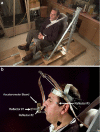The role of sternocleidomastoid muscle in simulated low velocity rear-end impacts
- PMID: 16133079
- PMCID: PMC3489442
- DOI: 10.1007/s00586-005-0956-9
The role of sternocleidomastoid muscle in simulated low velocity rear-end impacts
Abstract
The objectives of this study were to evaluate behavior of sternocleidomastoid muscle (SCM) electromyogram (EMG) related to impact velocity, gender, awareness and kinematics of head movement in simulated low velocity rear-end impacts. Twenty-nine healthy adults (17 male) were subjected in random order to three rear-end impacts: Two unexpected impacts causing chair accelerations of 4.5 m/s(2) (slow) and 10.1 m/s(2) (fast) and one 10.1 m/s(2) expected impact. Normalized left and right SCM EMG, linear head acceleration, angular head acceleration and maximum angular head displacement were recorded. The magnitude of normalized SCM EMG peak response ranged 2-3 times higher (P< 0.001) in female subjects than their counterpart male subjects. SCM EMG magnitude was 3-4 times higher (P< 0.001) for the fast unexpected than slow unexpected impacts, but there was no significant difference (P> 0.05) for the fast expected compared to the fast unexpected impacts. The onset time of SCM peak EMG ranged from 78 ms to 114 ms later than peak of linear head acceleration for all groups. Onset time of peak SCM EMG was not significantly different (P> 0.05) than onset of angular acceleration for the slow and fast-unexpected impacts, but onset peak SCM EMG was significantly earlier than peak angular head acceleration (30 ms) (P </= 0.05) for the fast expected impact. SCM EMG magnitude increased with increased impact velocity. Gender differences exist for SCM EMG magnitude. Temporal and amplitude awareness of a simulated impact do not produce different magnitude of SCM EMG response. The temporal relationship between the SCM and angular head acceleration is different from the temporal relationship between the SCM and linear head acceleration.
Figures



Similar articles
-
Masticatory muscle reaction in simulated low-velocity rear-end impacts.J Orofac Pain. 2006 Summer;20(3):199-207. J Orofac Pain. 2006. PMID: 16913429 Clinical Trial.
-
Kinematics of head movement in simulated low velocity rear-end impacts.Clin Biomech (Bristol). 2005 Dec;20(10):1011-8. doi: 10.1016/j.clinbiomech.2005.07.002. Epub 2005 Sep 13. Clin Biomech (Bristol). 2005. PMID: 16168533 Clinical Trial.
-
Mandibular kinematics associated with simulated low-velocity rear-end impacts.J Oral Rehabil. 2006 Aug;33(8):566-75. doi: 10.1111/j.1365-2842.2005.01555.x. J Oral Rehabil. 2006. PMID: 16856954
-
Kinematic and electromyographic response to whiplash loading in low-velocity whiplash impacts--a review.Clin Biomech (Bristol). 2005 May;20(4):343-56. doi: 10.1016/j.clinbiomech.2004.11.016. Epub 2005 Jan 12. Clin Biomech (Bristol). 2005. PMID: 15737441 Review.
-
Muscle activity during low-speed rear impact.Chin J Traumatol. 2019 Apr;22(2):80-84. doi: 10.1016/j.cjtee.2018.10.006. Epub 2019 Feb 27. Chin J Traumatol. 2019. PMID: 30962127 Free PMC article. Review.
Cited by
-
Evaluation of surface electromyography of selected neck muscles during the whiplash mechanism in aware and unaware conditions due to safe punching in kickboxing.BMC Musculoskelet Disord. 2023 May 30;24(1):429. doi: 10.1186/s12891-023-06563-y. BMC Musculoskelet Disord. 2023. PMID: 37254094 Free PMC article.
-
The nosological classification of whiplash-associated disorder: a narrative review.J Can Chiropr Assoc. 2021 Apr;65(1):76-93. J Can Chiropr Assoc. 2021. PMID: 34035543 Free PMC article.
-
Head and neck control varies with perturbation acceleration but not jerk: implications for whiplash injuries.J Physiol. 2009 Apr 15;587(Pt 8):1829-42. doi: 10.1113/jphysiol.2009.169151. Epub 2009 Feb 23. J Physiol. 2009. PMID: 19237420 Free PMC article.
-
Effect of muscle activation on dynamic responses of neck of pilot during emergency ejection: a finite element study.Med Biol Eng Comput. 2023 Sep;61(9):2255-2268. doi: 10.1007/s11517-023-02817-y. Epub 2023 Mar 28. Med Biol Eng Comput. 2023. PMID: 36976416 Review.
References
-
- Basmajian J, de Luca C (1985) Description and analysis of the EMG signal. In: Muscles alive: their functions revealed by electromyography, 5th edn. Williams and Wilkins, Baltimore, pp 65–100
-
- Brault JR, Siegmund GP, Wheeler JB. Cervical muscle response during whiplash: evidence of a lengthening muscle contraction. Clin Biomech (Bristol, Avon) 2000;15:426–435. - PubMed
Publication types
MeSH terms
LinkOut - more resources
Full Text Sources

